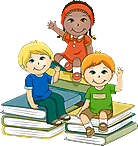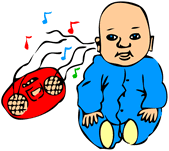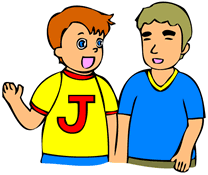Without the cooperation of its members society cannot survive, and the society of man has survived because the cooperativeness of its members made survival possible…. It was not an advantageous individual here and there who did so, but the group. In human societies the individuals who are most likely to survive are those who are best enabled to do so by their group.
(Ashley Montagu, 1965)
How students interact with each another is a neglected aspect of instruction. Much training time is devoted to helping teachers arrange appropriate interactions between students and materials (i.e., textbooks, curriculum programs) and some time is spent on how teachers should interact with students, but how students should interact with one another is relatively ignored. It should not be. How teachers structure student-student interaction patterns has a lot to say about how well students learn, how they feel about school and the teacher, how they feel about each other, and how much self-esteem they have.
In the mid-1960s, cooperative learning was relatively unknown and largely ignored by educators. Elementary, secondary, and university teaching was dominated by competitive and individualistic learning. Cultural resistance to cooperative learning was based on social Darwinism, with its premise that students must be taught to survive in a “dog-eat-dog” world, and the myth of “rugged individualism” underlying the use of individualistic learning. While competition dominated educational thought, it was being challenged by individualistic learning largely based on B. F. Skinner’s work on programmed learning and behavioral modification. Educational practices and thought, however, have changed. Cooperative learning is now an accepted and often the preferred instructional procedure at all levels of education. Cooperative learning is presently used in schools and universities in every part of the world, in every subject area, and with every age student. It is difficult to find a text on instructional methods, a teacher’s journal, or instructional materials that do not discuss cooperative learning. Materials on cooperative learning have been translated into dozens of languages. Cooperative learning is now an accepted and highly recommended instructional procedure.
Definition of Cooperative Learning
Students’ learning goals may be structured to promote cooperative, competitive, or individualistic efforts. In every classroom, instructional activities are aimed at accomplishing goals and are conducted under a goal structure. A learning goal is a desired future state of demonstrating competence or mastery in the subject area being studied. The goal structure specifies the ways in which students will interact with each other and the teacher during the instructional session. Each goal structure has its place (Johnson & Johnson, 1989, 1999). In the ideal classroom, all students would learn how to work cooperatively with others, compete for fun and enjoyment, and work autonomously on their own. The teacher decides which goal structure to implement within each lesson. The most important goal structure, and the one that should be used the majority of the time in learning situations, is cooperation.
Cooperation is working together to accomplish shared goals. Within cooperative situations, individuals seek outcomes that are beneficial to themselves and beneficial to all other group members. Cooperative learning is the instructional use of small groups so that students work together to maximize their own and each other’s learning. It may be contrasted with competitive (students work against each other to achieve an academic goal such as a grade of “A” that only one or a few students can attain) andindividualistic (students work by themselves to accomplish learning goals unrelated to those of the other students) learning. In cooperative and individualistic learning, you evaluate student efforts on a criteria-referenced basis while in competitive learning you grade students on a norm-referenced basis. While there are limitations on when and where you may use competitive and individualistic learning appropriately, you may structure any learning task in any subject area with any curriculum cooperatively.
Theorizing on social interdependence began in the early 1900s, when one of the founders of the Gestalt School of Psychology, Kurt Koffka, proposed that groups were dynamic wholes in which the interdependence among members could vary. One of his colleagues, Kurt Lewin refined Koffka’s notions in the 1920s and 1930s while stating that (a) the essence of a group is the interdependence among members (created by common goals) which results in the group being a “dynamic whole” so that a change in the state of any member or subgroup changes the state of any other member or subgroup, and (b) an intrinsic state of tension within group members motivates movement toward the accomplishment of the desired common goals. For interdependence to exist, there must be more than one person or entity involved, and the persons or entities must have impact on each other in that a change in the state of one causes a change in the state of the others. From the work of Lewin’s students and colleagues, such as Ovisankian, Lissner, Mahler, and Lewis, it may be concluded that it is the drive for goal accomplishment that motivates cooperative and competitive behavior.
In the late 1940s, one of Lewin’s graduate students, Morton Deutsch, extended Lewin’s reasoning about social interdependence and formulated a theory of cooperation and competition (Deutsch, 1949, 1962). Deutsch conceptualized three types of social interdependence–positive, negative, and none. Deutsch’s basic premise was that the type of interdependence structured in a situation determines how individuals interact with each other which, in turn, largely determines outcomes. Positive interdependence tends to result in promotive interaction, negative interdependence tends to result in oppositional or contrient interaction, and no interdependence results in an absence of interaction. Depending on whether individuals promote or obstruct each other’s goal accomplishments, there is substitutability, cathexis, and inducibility. The relationships between the type of social interdependence and the interaction pattern it elicits is assumed to be bidirectional. Each may cause the other. Deutsch’s theory has served as a major conceptual structure for this area of inquiry since 1949.
Types Of Cooperative Learning
Formal Cooperative Learning
Formal cooperative learning consists of students working together, for one class period to several weeks, to achieve shared learning goals and complete jointly specific tasks and assignments (Johnson, Johnson, & Holubec, 2008). In formal cooperative learning groups the teachers’ role includes (see Figure 4):
1. Making preinstructional decisions. Teachers (a) formulate both academic and social skills objectives, (b) decide on the size of groups, (c) choose a method for assigning students to groups, (d) decide which roles to assign group members, (e) arrange the room, and (f) arrange the materials students need to complete the assignment. In these preinstructional decisions, the social skills objectives specify the interpersonal and small group skills students are to learn. By assigning students roles, role interdependence is established. The way in which materials are distributed can create resource interdependence. The arrangement of the room can create environmental interdependence and provide the teacher with easy access to observe each group, which increases individual accountability and provides data for group processing.
2. Explaining the instructional task and cooperative structure.Teachers (a) explain the academic assignment to students, (b) explain the criteria for success, (c) structure positive interdependence, (d) structure individual accountability, (e) explain the behaviors (i.e., social skills) students are expected to use, and (f) emphasize intergroup cooperation (this eliminates the possibility of competition among students and extends positive goal interdependence to the class as a whole). Teachers may also teach the concepts and strategies required to complete the assignment. By explaining the social skills emphasized in the lesson, teachers operationalize (a) the social skill objectives of the lesson and (b) the interaction patterns (such as oral rehearsal and jointly building conceptual frameworks) teachers wish to create.
3. Monitoring students’ learning and intervening to provide assistance in (a) completing the task successfully or (b) using the targeted interpersonal and group skills effectively.While conducting the lesson, teachers monitor each learning group and intervene when needed to improve taskwork and teamwork. Monitoring the learning groups creates individual accountability; whenever a teacher observes a group, members tend to feel accountable to be constructive members. In addition, teachers collect specific data on promotive interaction, the use of targeted social skills, and the engagement in the desired interaction patterns. This data is used to intervene in groups and to guide group processing.
4. Assessing students’ learning and helping students process how well their groups functioned. Teachers (a) bring closure to the lesson, (b) assess and evaluate the quality and quantity of student achievement, (c) ensure students carefully discuss how effectively they worked together (i.e., process the effectiveness of their learning groups), (d) have students make a plan for improvement, and (e) have students celebrate the hard work of group members. The assessment of student achievement highlights individual and group accountability (i.e., how well each student performed) and indicates whether the group achieved its goals (i.e., focusing on positive goal interdependence). The group celebration is a form of reward interdependence. The feedback received during group processing is aimed at improving the use of social skills and is a form of individual accountability. Discussing the processes the group used to function, furthermore, emphasizes the continuous improvement of promotive interaction and the patterns of interaction need to maximize student learning and retention.
Informal Cooperative Learning
Informal cooperative learning consists of having students work together to achieve a joint learning goal in temporary, ad-hoc groups that last from a few minutes to one class period (Johnson, Johnson, & Holubec, 2008). During a lecture, demonstration, or film, informal cooperative learning can be used to focus student attention on the material to be learned, set a mood conducive to learning, help set expectations as to what will be covered in a class session, ensure that students cognitively process and rehearse the material being taught, summarize what was learned and precue the next session, and provide closure to an instructional session. The teacher’s role for using informal cooperative learning to keep students more actively engaged intellectually entails having focused discussions before and after the lesson (i.e., bookends) and interspersing pair discussions throughout the lesson. Two important aspects of using informal cooperative learning groups are to (a) make the task and the instructions explicit and precise and (b) require the groups to produce a specific product (such as a written answer). The procedure is as follows.
1. Introductory Focused Discussion: Teachers assign students to pairs or triads and explain (a) the task of answering the questions in a four to five minute time period and (b) the positive goal interdependence of reaching consensus. The discussion task is aimed at promoting advance organizing of what the students know about the topic to be presented and establishing expectations about what the lecture will cover. Individual accountability is ensured by the small size of the group. A basic interaction pattern of eliciting oral rehearsal, higher-level reasoning, and consensus building is required.
2. Intermittent Focused Discussions: Teachers divide the lecture into 10 to 15 minute segments. This is about the length of time a motivated adult can concentrate on information being presented. After each segment, students are asked to turn to the person next to them and work cooperatively in answering a question (specific enough so that students can answer it in about three minutes) that requires students to cognitively process the material just presented. The procedure is:
a. Each student formulates his or her answer.
b. Students share their answer with their partner.
c. Students listen carefully to their partner’s answer.
d. The pairs create a new answer that is superior to each member’s initial formulation by integrating the two answers, building on each other’s thoughts, and synthesizing.
The question may require students to:
a. Summarize the material just presented.
b. Give a reaction to the theory, concepts, or information presented.
c. Predict what is going to be presented next; hypothesize.
d. Solve a problem.
e. Relate material to past learning and integrate it into conceptual frameworks.
f. Resolve conceptual conflict created by presentation.
Teachers should ensure that students are seeking to reach an agreement on the answers to the questions (i.e., ensure positive goal interdependence is established), not just share their ideas with each other. Randomly choose two or three students to give 30 second summaries of their discussions. Such individual accountabilityensures that the pairs take the tasks seriously and check each other to ensure that both are prepared to answer. Periodically, the teacher should structure a discussion of how effectively the pairs are working together (i.e., group processing). Group celebrations add reward interdependence to the pairs.
3. Closure Focused Discussion: Teachers give students an ending discussion task lasting four to five minutes. The task requires students to summarize what they have learned from the lecture and integrate it into existing conceptual frameworks. The task may also point students toward what the homework will cover or what will be presented in the next class session. This provides closure to the lecture.
Informal cooperative learning ensures students are actively involved in understanding what is being presented. It also provides time for teachers to move around the class listening to what students are saying. Listening to student discussions can give instructors direction and insight into how well students understand the concepts and material being as well as increase the individual accountability of participating in the discussions.
Cooperative Base Groups
Cooperative base groups are long-term, heterogeneous cooperative learning groups with stable membership (Johnson, Johnson, & Holubec, 2008). Members’ primary responsibilities are to (a) ensure all members are making good academic progress (i.e., positive goal interdependence) (b) hold each other accountable for striving to learn (i.e., individual accountability), and (c) provide each other with support, encouragement, and assistance in completing assignments (i.e., promotive interaction). In order to ensure the base groups function effectively, periodically teachers should teach needed social skills and have the groups process how effectively they are functioning. Typically, cooperative base groups are heterogeneous in membership (especially in terms of achievement motivation and task orientation), meet regularly (for example, daily or biweekly), and last for the duration of the class (a semester or year) or preferably for several years. The agenda of the base group can include academic support tasks (such as ensuring all members have completed their homework and understand it or editing each other’s essays), personal support tasks (such as getting to know each other and helping each other solve nonacademic problems), routine tasks (such as taking attendance), and assessment tasks (such as checking each other’s understanding of the answers to test questions when the test is first taken individually and then retaken in the base group).
The teacher’s role in using cooperative base groups is to (a) form heterogeneous groups of four (or three), (b) schedule a time when they will regularly meet (such as beginning and end of each class session or the beginning and end of each week), (c) create specific agendas with concrete tasks that provide a routine for base groups to follow when they meet, (d) ensure the five basic elements of effective cooperative groups are implemented, and (e) have students periodically process the effectiveness of their base groups.
The longer a cooperative group exists, the more caring their relationships will tend to be, the greater the social support they will provide for each other, the more committed they will be to each other’s success, and the more influence members will have over each other. Permanent cooperative base groups provide the arena in which caring and committed relationships can be created that provide the social support needed to improve attendance, personalize the educational experience, increase achievement, and improve the quality of school life.
Integrated Use Of All Three Types Of Cooperative Learning
These three types of cooperative learning may be used together (Johnson, Johnson, & Holubec, 2008). A typical class session may begin with a base group meeting, which is followed by a short lecture in which informal cooperative learning is used. The lecture is followed by a formal cooperative learning lesson. Near the end of the class session another short lecture may be delivered with the use of informal cooperative learning. The class ends with a base group meeting.
Basic Elements of Cooperation
Not all groups are cooperative (Johnson & F. Johnson, 2009). Placing people in the same room, seating them together, telling them they are a group, does not mean they will cooperate effectively. To be cooperative, to reach the full potential of the group, five essential elements need to be carefully structured into the situation: positive interdependence, individual and group accountability, promotive interaction, appropriate use of social skills, and group processing (Johnson & Johnson, 1989, 2005). Mastering the basic elements of cooperation allows teachers to:
1. Take existing lessons, curricula, and courses and structure them cooperatively.
2. Tailor cooperative learning lessons to unique instructional needs, circumstances, curricula, subject areas, and students.
3. Diagnose the problems some students may have in working together and intervene to increase the effectiveness of the student learning groups.
The first and most important element is positive interdependence. Teachers must give a clear task and a group goal so students believe they “sink or swim together.” Positive interdependenceexists when group members perceive that they are linked with each other in a way that one cannot succeed unless everyone succeeds. If one fails, all fail. Group members realize, therefore, that each person’s efforts benefit not only him- or herself, but all other group members as well. Positive interdependence creates a commitment to other people’s success as well as one’s own and is the heart of cooperative learning. If there is no positive interdependence, there is no cooperation.
The second essential element of cooperative learning is individual and group accountability. The group must be accountable for achieving its goals. Each member must be accountable for contributing his or her share of the work (which ensures that no one “hitch-hikes” on the work of others). The group has to be clear about its goals and be able to measure (a) its progress in achieving them and (b) the individual efforts of each of its members. Individual accountability exists when the performance of each individual student is assessed and the results are given back to the group and the individual in order to ascertain who needs more assistance, support, and encouragement in completing the assignment. The purpose of cooperative learning groups is to make each member a stronger individual in his or her right. Students learn together so that they can subsequently perform higher as individuals.
The third essential component of cooperative learning is promotive interaction, preferably face-to-face. Promotive interactionoccurs when members share resources and help, support, encourage, and praise each other’s efforts to learn. Cooperative learning groups are both an academic support system (every student has someone who is committed to helping him or her learn) and a personal support system (every student has someone who is committed to him or her as a person). There are important cognitive activities and interpersonal dynamics that can only occur when students promote each other’s learning. This includes orally explaining how to solve problems, discussing the nature of the concepts being learned, teaching one’s knowledge to classmates, and connecting present with past learning. It is through promoting each other’s learning face-to-face that members become personally committed to each other as well as to their mutual goals.
The fourth essential element of cooperative learning is teaching students the required interpersonal and small group skills. In cooperative learning groups students are required to learn academic subject matter (taskwork) and also to learn the interpersonal and small group skills required to function as part of a group (teamwork). Cooperative learning is inherently more complex than competitive or individualistic learning because students have to engage simultaneously in taskwork and teamwork. Group members must know how to provide effective leadership, decision-making, trust-building, communication, and conflict-management, and be motivated to use the prerequisite skills. Teachers have to teach teamwork skills just as purposefully and precisely as teachers do academic skills. Since cooperation and conflict are inherently related, the procedures and skills for managing conflicts constructively are especially important for the long-term success of learning groups. Procedures and strategies for teaching students social skills may be found in Johnson (2009) and Johnson and F. Johnson (2009).
The fifth essential component of cooperative learning is group processing. Group processing exists when group members discuss how well they are achieving their goals and maintaining effective working relationships. Groups need to describe what member actions are helpful and unhelpful and make decisions about what behaviors to continue or change. Continuous improvement of the process of learning results from the careful analysis of how members are working together.
These five elements are essential to all cooperative systems, no matter what their size. When international agreements are made and when international efforts to achieve mutual goals (such as environmental protection) occur, these five elements must be carefully implemented and maintained.
The Validating Research
Amount And Characteristics Of Research
The study of cooperative, competitive, and individualistic efforts is commonly recognized as one of the oldest fields of research in social psychology. In the late 1800’s Triplett in the United States, Turner in England, and Mayer in Germany conducted a series of studies on the factors associated with competitive performance. Since then over 750 studies have been conducted on the relative merits of cooperative, competitive, and individualistic efforts and the conditions under which each is appropriate. This is one of the largest bodies of research within psychology and education.
An extensive literature search was conducted aimed at identifying all the available studies from published and nonpublished sources. Seven-hundred-fifty-four studies contained enough data to compute an effect size (there are many studies from which an effect size could not be computed) (Johnson & Johnson, 1989). The research on social interdependence, furthermore, has an external validity and a generalizability rarely found in the social sciences. The more variations in places, people, and procedures the research can withstand and still yield the same findings, the more externally valid the conclusions. The research has been conducted over twelve decades by many different researchers with markedly different theoretical and practical orientations working in different settings and countries. A wide variety of research tasks, ways of structuring social interdependence, and measures of the dependent variables have been used. Participants in the studies varied from ages three to post-college adults and have come from different economic classes and cultural backgrounds. The studies were conducted with different durations, lasting from one session to 100 sessions or more. Research on social interdependence has been conducted in numerous cultures in North America (with Caucasian, Black-American, Native-American, and Hispanic populations) and countries from North, Central, and South America, Europe, the Middle East, Asia, the Pacific Rim, and Africa. The research on social interdependence includes both theoretical and demonstration studies conducted in educational, business, and social service organizations. The diversity of these studies gives social interdependence theory wide generalizability and considerable external validity.
Promotive, oppositional, and no interaction have differential effects on the outcomes of the situation (see Johnson & Johnson, 1989, 2005). The research has focused on numerous outcomes, which may be subsumed within the broad and interrelated categories of effort to achieve, quality of relationships, and psychological health (Johnson, 2003; Johnson & Johnson, 1989, 2005) (see Table 1 and Figure 2). Figure 1 shows the relationships among the outcomes.
Table 1
Mean Effect Sizes For Impact Of Social Interdependence On Dependent Variables
ConditionsAchievementInterpersonal AttractionSocial SupportSelf-Esteem
Total Studies
Coop vs. Comp0.670.670.620.58
Coop vs. Ind0.640.600.700.44
Comp vs. Ind0.300.08-0.13-0.23
High Quality Studies
Coop vs. Comp0.880.820.830.67
Coop vs. Ind0.610.620.720.45
Comp vs. Ind0.070.27-0.13-0.25
Note: Coop = Cooperation, Comp = Competition, Ind = Individualistic
Reprinted By Permission From: Johnson, D. W. & Johnson, R. (1989). Cooperation and Competition: Theory and Research.Edina, MN: Interaction Book Company
Effort To Achieve
From Table 1 it may be seen that cooperation promotes considerable greater effort to achieve than do competitive or individualistic efforts. Effort exerted to achieve includes such variables as achievement and productivity, long-term retention, on-task behavior, use of higher-level reasoning strategies, generation of new ideas and solutions, transfer of what is learned within one situation to another, intrinsic motivation, achievement motivation, continuing motivation to learn, and positive attitudes toward learning and school. Overall, cooperation tends to promote higher achievement than competitive or individualistic efforts (effect-sizes = 0.67 and 0.64 respectively). The impact of cooperative learning on achievement means that if schools wish to prepare students to take proficiency tests to meet local and state standards, the use of cooperative learning should dominate instructional practice.
An important aspect of school life is engagement in learning. One indication of engagement in learning is time on task. Cooperators spent considerably more time on task than did competitors (effect size = 0.76) or students working individualistically (effect size = 1.17). In addition, students working cooperatively tended to be more involved in activities and tasks, attach greater importance to success, and engage in more on-task behavior and less apathetic, off-task, disruptive behaviors. Finally, cooperative experiences, compared with competitive and individualistic ones, have been found to promote more positive attitudes toward the task and the experience of working on the task (effect-sizes = 0.57 and 0.42 respectively).
Quality Of Relationships
Quality of relationships includes such variables as interpersonal attraction, liking, cohesion, esprit-de-corps, and social support. The degree of emotional bonding that exists among students has a profound effect on students’ behavior. The more positive the relationships among students and between students and faculty, the lower the absenteeism and dropout rates and the greater the commitment to group goals, feelings of personal responsibility to the group, willingness to take on difficult tasks, motivation and persistence in working toward goal achievement, satisfaction and morale, willingness to endure pain and frustration on behalf of the group, willingness to defend the group against external criticism or attack, willingness to listen to and be influenced by colleagues, commitment to each other’s professional growth and success, and productivity (Johnson & F. Johnson, 2009).
There are over 175 studies that have investigated the relative impact of cooperative, competitive, and individualistic efforts on quality of relationships and another 106 studies on social support (Johnson, 2003; Johnson & Johnson, 1989, 2005). As Table 2 shows, cooperation generally promotes greater interpersonal attraction among individuals than does competitive or individualistic efforts (effect sizes = 0.67 and 0.60 respectively). Cooperative experiences tend to promote greater social support than does competitive (effect-size = 0.62) or individualistic (effect-size = 0.70) efforts. Stronger effects are found for peer support than for superior (teacher) support. The high-quality studies tend to have even more powerful effects.
It is difficult to overemphasize the importance of these research results. Friends are a developmental advantage (see Johnson, 2003; Johnson & Johnson, 1989, 2005). There is a close association between antisocial behavior and rejection by the normal peer group. Rejected children tend to be deficient in a number of social-cognitive skills, including peer group entry, perception of peer group norms, response to provocation, and interpretation of prosocial interactions. Among children referred to child guidance clinics, 30 to 75 percent (depending on age) are reported by their parents to experience peer difficulties. Moreover, children referred for psychological treatment have fewer friends and less contact with them than nonreferred children, their friendships are significantly less stable over time, and their understanding of the reciprocities and intimacies involved in friendships is less mature. Peer group acceptance and friendships may be built through the extensive use of cooperative learning.
Psychological Health
Asley Montagu (1966) was fond of saying that with few exceptions the solitary animal in any species is an abnormal creature. Similarly, Karen Horney (1937) stated that the neurotic individual is someone who is inappropriately competitive and, therefore, unable to cooperate with others. Montagu and Horney recognized that the essence of psychological health is the ability to develop and maintain cooperative relationships. More specifically, psychological health is the ability (cognitive capacities, motivational orientations, and social skills) to build, maintain, and appropriately modify interdependent relationships with others to succeed in achieving goals (Johnson, 2003; Johnson & Johnson, 1989, 2005). People who are unable to do so often (a) become depressed, anxious, frustrated, and lonely, (b) tend to feel afraid, inadequate, helpless, hopeless, and isolated, and (c) rigidly cling to unproductive and ineffective ways of coping with adversity.
With our students and colleagues, we have conducted a series of studies relating cooperative, competitive, and individualistic efforts and attitudes to various indices of psychological health (see Johnson, 2003; Johnson & Johnson, 1989, 2005). The samples studied included middle-class junior-high students, middle-class high school seniors, high-school age juvenile prisoners, adult prisoners, Olympic ice-hockey players, adult step-couples, and business executives in China. The diversity of the samples studied and the variety of measures of psychological health provide considerable generalizability of the results of the studies. A strong relationship was found between cooperativeness and psychological health, a mixed picture was found with competitiveness and psychological health, and a strong relationship was found between an individualistic orientation and psychological pathology.
Finally, there is evidence that cooperation promotes more frequent use of higher level reasoning strategies than do competitive (effect size = 0.93) or individualistic (effect size = 0.97) efforts. Similarly, cooperation tends to promote more accurate perspective taking than do competitive (effect size = 0.61) or individualistic (effect size = 0.44) efforts. Thus, the more cooperative learning experiences students are involved in, the more mature their cognitive and moral decision making and the more they will tend to take other people’s perspectives in account when making decisions.
Conclusions and Summary
Teachers who wish to use cooperative learning should ideally base their classroom practices on theory validated by research. The closer classroom practices are to validated theory, the more likely they will be effective. When more directly practice is connected to theory, furthermore, the more likely practice will be refined, upgraded, and improved over the years. There are, however, few classroom practices that are directly based on validated theory. The close relationship between theory, research, and practice makes cooperative learning somewhat unique. It also creates a set of issues for teachers using cooperative learning.
The first issue is understanding the nature of social interdependence. Social interdependence is created when goals are structured so that the accomplishment of a person’s goal is affected by others’ actions. The interdependence may be positive (which results in individuals working cooperatively to achieve their mutual goals) or negative (which results in individuals competing to see who will achieve the goal). The absence of interdependence indicates no connection between people’s attempts to achieve their goals. In cooperative situations, students’ actions substitute for each other, students are inducible, and a positive cathexis is created toward other’s actions. In competitive situations, the opposite psychological processes may be found. The fundamental premise of social interdependence theory is that the way in which goals are structured determines how individuals interact, and those interaction patterns create outcomes. Positive goal interdependence tends to result in promotive interaction, negative goal interdependence tends to result in oppositional interaction, and no interdependence tends to result in no interaction.
The second issue is understanding the research validating social interdependence theory. There are hundreds of studies indicating that cooperation, compared to competitive and individualistic efforts, tends to result in greater effort to achieve, more positive relationships, and greater psychological health. The diversity of this research provides considerable generalizabiity to the findings.
The third issue is to understand the five basic elements that make cooperation work. There is nothing magical about putting students in groups. Students can compete with groupmates, students can work individualistically while ignoring groupmates, or students can work cooperatively with groupmates. In order to structure cooperative learning effectively, teachers need to understand how tostructure positive interdependence, individual accountability, promotive interaction, appropriate use of social skills, and group processing into learning situations.
The fourth issue is to understand the flexibility and many faces of cooperative learning. When the five basic elements may be effectively implemented in formal cooperative learning situations (formal cooperative learning may be used to structure most learning situations), informal cooperative learning situations (informal cooperative learning may be used to make didactic lessons cooperative), and cooperative base groups (which are used to personalize a class and the school). Together they provide an integrated system for instructional organization and design (as well as classroom management). When utilizing these three types of cooperative learning, any learning situations in any subject area with any age students and with any curriculum can be structured cooperatively.

 Visual learners respond well to:
Visual learners respond well to: Auditory learners respond well to:
Auditory learners respond well to: Tactile learners respond well to:
Tactile learners respond well to: Kinesthetic learners respond well to:
Kinesthetic learners respond well to: Analytic learners respond well to:
Analytic learners respond well to: Global learners respond well to:
Global learners respond well to: